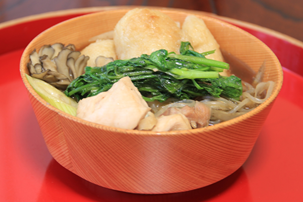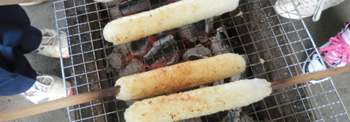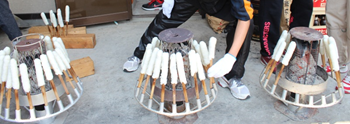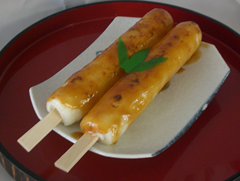
The origin of Kiritampo
To begin with ‘kiritampo’ originated in Hokuroku area in Odate. It is been said that in the old times, people who stayed in the forest to cut the Akita cedar trees and collect charcoal used to knead the leftover rice. They put them in the tori-nabe (chiken nabe) or they spread the miso on to it and that was the beginning of ‘kiritampo’.
Other stories say that the Matagi (a type of hunter) used to put the leftover rice into the nabe and that was the origin of this food.
‘Kiritampo’ is generally made at home.
Each family passes onto the next generation their version of kiritampo calling it ‘ofukuro no aji’ meaning the taste of mother’s cooking.
Again, it is also a cuisine prepared for the guests when they are welcomed as it is also prepared for ceremonial occasions.
In autumn, when the new rice is being sold, there are many events held in the city to savour the kiritampo that is made together with hinaijidori chicken. The city is filled with kiritampo.
kiritampo is deeply ingrained into the Odate people.
This culture had managed to preserve the old kiritampo until now.
How to make ‘kiritampo-nabe’
Necessary tools
- Wooden pestle, mortar, Akita cedar tree skewer (Please call Odate Tourism Associtaion for any purchase [TEL 0186-42-4360])
- A stick holder to hold the “tampo”. (It can be replaced with something heavy and unburnable)
- Charcoal (Use the charcoals for barbeque)
-
Cook rice a little hard, transfer it into the mortar adding a little bit of salted water in order to make the whole rice wet. Use the pestle as if you’re kneading it. Do not be afraid to do it forcefully.
※Please take care if you use the rice cooker’s bowl, the inner layer of the bowl may peel off when you use the pestle.
-
When the rice starts to become sticky, take a good amount to put on the Akita cedar’s skewer and straighten it out.
Not too thick and not too thin. Enough to cover the stick with the rice.


-
Roll it and make the appearance neat. If there are lumps use salted water and roll it on the chopping board.


-
Grill the ‘tampo’ until the surface becomes light brown.

-
Preparation of kiritampo-nabe is done once you have prepared the ingredients and the tampo.
《Ingredients》Burdock root (in pieces), Green onion, chicken (hinaijidori), maitake mushrooms, Japanese parsley
※ If you are using ‘tampo’ that is been already sold in the stores, please warm it up in a microwave for 2mins.
Approximately 1.5 to 2 ‘tampo’ per person is an average amount to eat.
- To make the soup stock, put the chicken bones into the pot with water and boil.
※ If you are using the soup stock that is already sold in stores, please read the instructions. - Put in burdock root, chicken (hinaijidori), and Maitake mushrooms.
※ If you are using the ready-made soup stock, put the ingredients in when the soup is boiled up. -
Once the chicken and the burdock root are cooked well, season it with soy sauce (if you prefer to add Japanese sake or salt, you may).
Do not use chemical seasonings.
※ The hinaijidori soup that is been sold in the market already has a taste and you may adjust it.
- Tear the “tampo” into good size and add it into the nabe. Boil for 2 to 3 minutes and put in the green onions.
※ The “tampo” becomes “kiritampo” when it is cut.
- Lastly include the Japanese parsley and it is complete! (Soaking the parsley in the soup is enough).

Please arrange it on a plate.


☆ The grilled ‘tampo’ spread with sweet miso paste is called “misotsuketampo” which is also our recommendation.

※ In Akita prefecture we tend to see many “misotuketampo” in tourist site. Therefore, many tourist think “misotuketampo” is “tampo” but in Akita prefecture “tampo” is referred to “kiritampo-nabe”.
Yamada-style kiritampo is to use hinajidori of high quality as it is a necessary ingredient. kiritampo and Hinaijidori cannot be separated.
Characteristics
- Use and cook hinaijidori.
- Use the hinijidori soup stock.
- Do not include Konnyaku noodles and Shitake Mushrooms.
- Use Shimeji or Maitake Mushrooms.
- Cut the burdock root into thin pieces, and use boiled taros, green onions, Japanese parsley.
- Put the Japanese parsley into the soup for a little bit, do not let it lose its greenness.
- Do not use chemical seasonings. Add some Japanese sake.
Others
- Tear the tampo with your hands.
- Putting the petal of chrysanthemum will give some exceptional fragrance.
- Pouring kata (spicy taste) radish squeezed out juice on it also gives out a different taste.
This is the basics of Yamda-style kiritampo.
Odate kiritampo Association Home Page
It has a list of shops that you can taste and buy the real Odate’s kiritampo.
Real Odate’s kiritampo Matsuri (kiritampo’s festival)
There are may events to experience from “Real Odate kiritampo Matsuri” in October, when the new rice is ready; such as, eating different kiritampo and making your own misotsuketampo.
